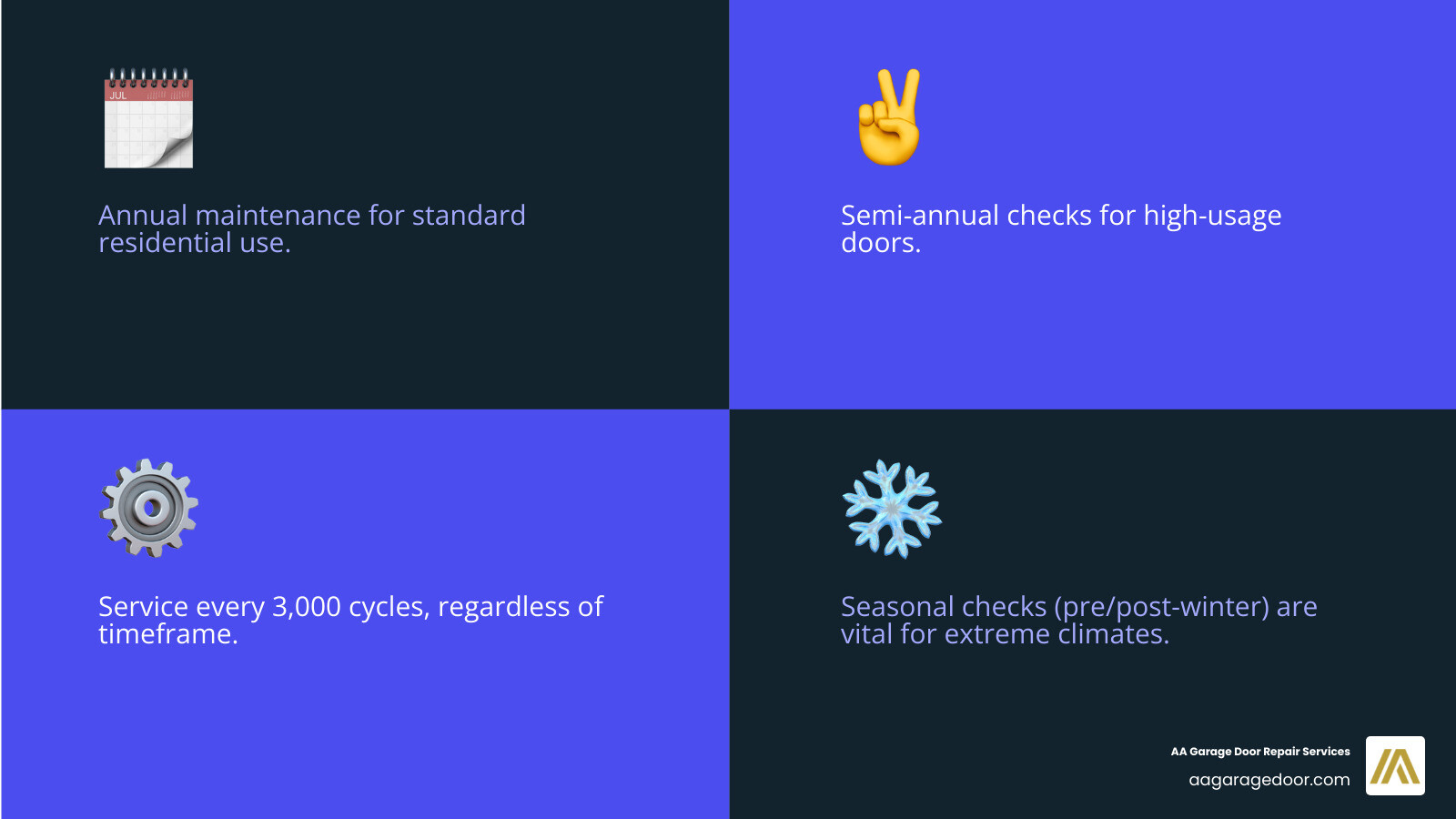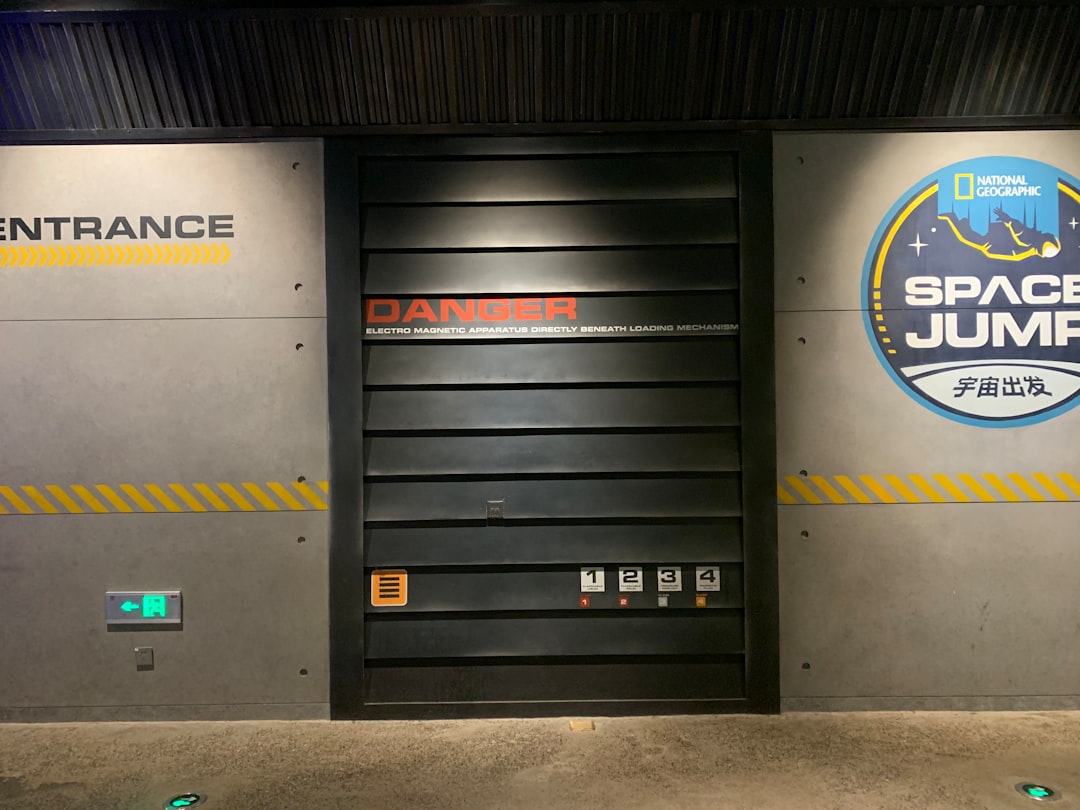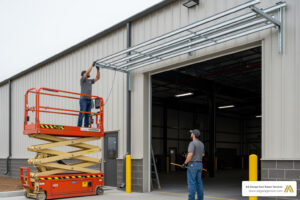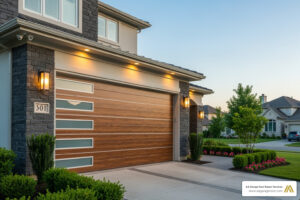Why Your Garage Door Deserves Regular Attention
Understanding how often do garage doors need maintenance is crucial for homeowners, especially in the harsh climates of Minnesota and Wisconsin. Your garage door is the largest moving part of your home, and without proper care, it can become a safety hazard. Regular professional garage door services ensure your door operates safely, preventing minor issues from becoming major expenses. The simple answer for maintenance frequency is:
- Once per year for standard use
- Twice per year for high-usage doors
- Every 3,000 cycles
- Before and after winter in extreme climates
Each cycle—and a typical family door sees over 1,800 a year—stresses springs, rollers, and cables. In our region’s weather, metal parts expand, contract, and face corrosion. I’m David Sands, owner of AA Garage Door Repair Services. With over 23 years of experience in the Twin Cities, I’ve seen that proactive maintenance prevents 80% of emergency calls, keeping families safe and avoiding costly surprises.

Simple how often do garage doors need maintenance word guide:
The Golden Rule: How Often Do Garage Doors Need Maintenance?
The straightforward rule is that most residential garage doors need professional attention once per year. However, if your door is a high-traffic main entry, bump that up to every six months. For the heaviest use, service is needed every 3,000 cycles of opening and closing. Three key factors determine your ideal schedule: how much you use your door, what Mother Nature throws at it, and how old your system is.
Usage Frequency: The Daily Grind
Your garage door is often the main entrance to your home. For many families in St. Paul and Minneapolis, opening it five times daily means over 1,800 cycles a year. This constant use wears on springs, cables, rollers, and the opener. High-use doors need semi-annual service to prevent simple wear from becoming an expensive repair. Low-use doors might stretch to 18 months, but an annual check is still the safest bet.
Weather’s Toll: Climate Considerations for MN & WI
Minnesota and Wisconsin weather is tough on garage doors. Extreme cold makes components stiff and thickens lubricants, forcing your opener to work harder. Summer humidity causes rust and corrosion. This constant expansion and contraction can loosen hardware and misalign your door. We strongly recommend seasonal checks, especially before winter and in early spring, to counteract these effects.
Age and Condition: Why Older Doors Need More Attention
Like any system, garage doors age. Newer doors may be fine with annual service, but doors over 10 years old need more frequent checkups. Garage doors typically last 15 to 30 years, and openers 9 to 15 years. As they age, parts like springs and rollers are more prone to fatigue and failure. Springs are especially critical, as they can break without warning when they reach their cycle limit. If your door is over a decade old, consider more frequent maintenance to extend its life safely. For practical tips, check out our 10 Garage Door Maintenance Tips.
Warning Signs: Is Your Garage Door Crying for Help?
Your garage door communicates through sounds and movements, and noticing these signs early can prevent costly emergency repairs. Between scheduled maintenance, stay alert for changes. A door crying for help today can be a safety hazard tomorrow.
Listen for Trouble: Decoding Garage Door Noises
A quiet door is a happy door. If yours is suddenly noisy, it’s a warning.
- Grinding sounds often mean metal-on-metal contact from worn opener gears or a misaligned chain.
- Scraping noises suggest something is blocking the tracks, like worn rollers or debris.
- Squeaking or rattling is usually a call for lubrication on rollers and hinges or a sign of loose bolts.
- A loud popping sound is a major red flag. It’s likely a broken torsion spring, which is a serious safety issue. These springs are under extreme tension. Do not operate the door and call us immediately at (651) 702-1420.
Watch for Glitches: Visual and Operational Cues
Visual checks can reveal problems before you hear them.
- Slow or jerky movement can point to worn springs, misaligned tracks, or a strained opener.
- Uneven closing, where one side hits the ground first, puts immense strain on the system and signals issues with springs or cables.
- Sagging door sections compromise both function and safety, indicating structural or balance problems.
- Frayed or broken cables are a critical issue. They are under high tension and require immediate professional attention.
- A door off its track is a clear emergency. Do not try to force it back into place.
Understanding these signs helps you know when your door needs immediate attention, regardless of its maintenance schedule. For more on repairs, see our Essential Guide to Garage Door Repair: Keeping Your Door Safe and Functional.
The Maintenance Breakdown: DIY vs. Professional Service
There’s a clear line between DIY garage door maintenance and tasks requiring a professional. While simple checks are great, safety must come first. Anything involving high-tension springs, heavy lifting, or electrical work is a job for trained technicians.
Your DIY Maintenance Checklist
Regularly performing these tasks can help keep your door running smoothly between professional visits:
- Visual Inspection: Monthly, look for loose bolts, worn parts, or damage. Listen for odd noises.
- Clean Tracks: Wipe tracks with a damp cloth to remove debris.
- Lubricate Parts: A few times a year, apply a silicone-based lubricant to metal rollers, hinges, and springs. Avoid plastic parts.
- Test Auto-Reverse: Place a wood block in the door’s path. It should reverse on contact. If not, call a pro.
- Check Photo-Eye Sensors: Ensure sensors (4-6 inches off the floor) are clean and aligned. The door shouldn’t close if an object blocks them.
- Replace Remote Batteries: An easy fix for an unresponsive remote.
For more details, see our 6 Tips to Maintain Your Garage Door.
When to Call the Pros for Garage Door Service
While DIY care is helpful, critical tasks demand professional expertise to avoid injury.
| Task Category | DIY (Homeowner) | Professional Service (AA Garage Door) |
|---|---|---|
| Inspection | Visual checks for obvious issues. | Comprehensive multi-point inspection, diagnosis of noises/movements. |
| Lubrication & Cleaning | Cleaning tracks, general lubrication. | Deep cleaning, precise lubrication with specialized products. |
| Safety Tests | Basic auto-reverse and photo-eye tests. | Thorough testing and adjustment of all safety features and force settings. |
| Hardware | Tightening visible, non-tension bolts. | Tightening all hardware, replacing worn rollers and hinges. |
| Springs & Cables | NO DIY. Visually inspect from a distance. | Safe replacement or adjustment of broken/worn springs and cables. These are under extreme tension and dangerous. |
| Opener | Replacing remote batteries. | Repairing motors, circuit boards, gears, and electrical issues. |
| Door Alignment/Balance | Simple manual lift test. | Professional rebalancing of the door and track realignment. |
| Panel/Section Issues | Minor cleaning. | Repair or replacement of damaged panels. |
| Emergency Services | None. | 24/7 service for doors off track, broken springs, or any safety/security issue. |
If you have a broken spring, a door off its tracks, or major opener problems, it’s time to call us. Our technicians have the tools and training for safe, effective garage door repair.
The Payoff: Why Regular Maintenance is a Smart Investment
Regular garage door maintenance is a smart investment, much like oil changes for your car. It’s about protecting your family and your wallet by choosing preventative care over reactive panic. A tune-up might cost $75-$150, while emergency repairs like a spring replacement can run $150-$400, and a new opener can cost up to $1,000. Beyond the savings, you get peace of mind. For more on costs, check out our guide on how much garage door maintenance costs.
How often do garage doors need maintenance to ensure safety?
Your garage door weighs hundreds of pounds. A failure can be catastrophic. Regular maintenance ensures safety systems work correctly.
- Preventing Accidents: A broken spring can cause the door to slam shut with dangerous force.
- Functioning Sensors: Malfunctioning auto-reverse sensors are a common but preventable hazard. We test them thoroughly to ensure they detect obstructions.
- Spring Integrity: Broken springs are the most dangerous failure. Regular inspections can catch metal fatigue before a spring snaps.
Proper maintenance keeps your door a reliable, safe entry point for your family.
How often do garage doors need maintenance to save money?
Preventative care is always cheaper than emergency repairs.
- Avoiding Costly Repairs: A small squeak from a worn roller can escalate into track and opener damage if ignored. A $20 part can turn into a $500 job.
- Extending Component Lifespan: Lubrication and adjustments help a door last 25-30 years, instead of failing in half that time.
- Maintaining Energy Efficiency: In Minnesota winters, a well-sealed door with intact weatherstripping keeps cold air out and lowers your energy bills.
The investment in maintenance pays for itself through avoided repairs, longer equipment life, and energy savings.
Frequently Asked Questions about Garage Door Maintenance
After 23 years of helping homeowners across St. Paul, the Twin Cities, and Western Wisconsin, we’ve answered nearly every question about garage door care. Here are the most common ones.
What is the difference between garage door maintenance and repair?
Think of it as proactive vs. reactive care. Maintenance is scheduled, preventative service to keep your door healthy, like an oil change. Repair is fixing something that has already broken, like a snapped spring or a burnt-out motor. Regular maintenance dramatically reduces the need for expensive, unexpected repairs.
How much does professional garage door maintenance cost?
A typical annual tune-up is surprisingly affordable, usually running between $75 and $150. This includes a full inspection, lubrication, safety tests, and minor adjustments. While worn parts would be an additional cost, the cost of neglect is always higher. An emergency call can easily cost $400-$800—money saved by a simple maintenance visit. For a full breakdown, read our guide on How Much Does Garage Door Maintenance Cost?.
Can I over-lubricate my garage door?
Yes, and it’s a common mistake. Excess lubricant attracts dirt and grime, creating an abrasive paste that hinders movement. It can also cause rollers to slip instead of roll. Use a silicone-based or lithium-based spray designed for garage doors, applying only a light coat to metal hinges, roller bearings, and springs. Wipe away any excess. You should also avoid lubricating plastic parts, as it can cause damage over time.
Conclusion: Keep Your Door Running Smoothly for Years to Come
Understanding how often do garage doors need maintenance is key to smart homeownership. A simple annual professional service—or twice yearly for high-use doors—can save you thousands in emergency repairs and protect your family. The choice is simple: a small investment in maintenance or a large, unexpected bill when something breaks.
It’s about the safety of your family, the security of your home, and the peace of mind that your garage door will work when you need it most. Regular DIY checks combined with professional service for complex jobs like spring replacement ensure your door operates reliably for decades.
For homeowners throughout St. Paul, the Twin Cities, and Western Wisconsin, AA Garage Door Repair Services has provided reliable care since 2001. We understand the challenges our climate poses and are here to help. Don’t wait for a failure. Proactive maintenance is the best way to keep your door running smoothly.
Ready to give your garage door the care it deserves? Schedule your professional garage door maintenance today.








